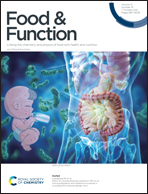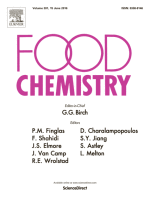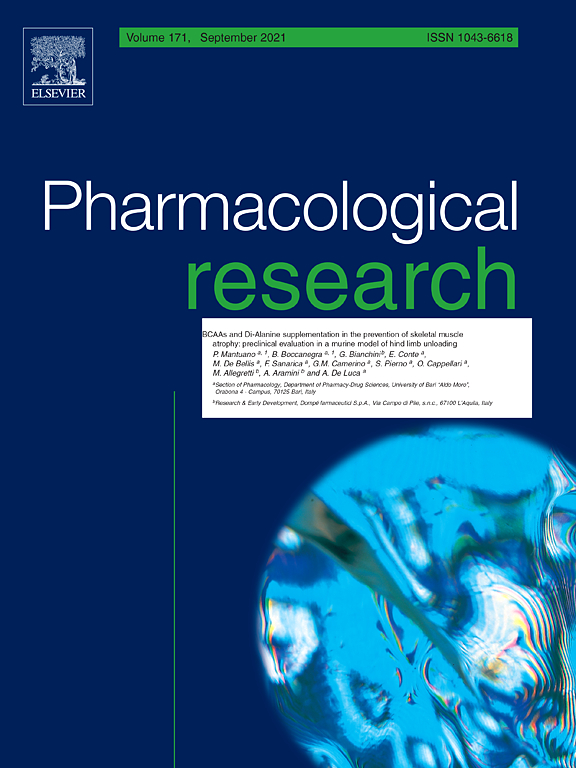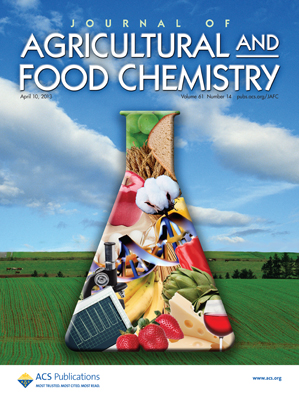Mulberry
How to submit an article:
- Registered users can submit any published journal article that has a unique DOI (Digital Object Identifier) name or link to Research Hub.
- For example, you can paste the full DOI link:
https://doi.org/10.1109/5.771073or just the DOI name:10.1109/5.771073into the field above and click submit. - The person who is first to submit a valid article to Research Hub will forever be credited for it, and every article submission earns you +6 Research Points.
Also known as: Sang Ye
Published research studies are articles that present the findings of original research that has undergone a peer-review process and has been made publicly available in scholarly journals, books or other media.

Goji berry leaf exerts a comparable effect against colitis and microbiota dysbiosis to its fruit in dextran-sulfate-sodium-treated mice
2023 Jan Food & Function Yu C, Chen Y, Ahmadi S, Wu D, Wu J, Ding T, et al.
Experimental Study Animal Study Anti-Inflammatory Goji Berry Leaf Gut Microbiota Colitis Anti-ColitisGoji berry leaves have stronger anti-colitis effects than mulberry leaves, ameliorating tissue damage and better regulating inflammatory responses and gut microbiota.

Phytochemistry, bioactivities and future prospects of mulberry leaves: A review
2022 Mar Food Chemistry Ma G, Chai X, Hou G, Zhao F, Meng Q
MLs and their extracts may be a promising treatment option for regulating glucose metabolism and lipid metabolism as well as anticancer effects. The dominant compounds responsible for the pharmacological effects of resisting oxidation, reducing blood sugar and lipids, resisting cancer and resisting inflammation in MLs include phenols, flavonoids, polysaccharides and alkaloids. Furthermore, ML suggests ability to inhibit multiple oxidase as well as anti-diabetic effects however more research is needed to yield stronger suggestions
Review Article Sang Ye
Mulberry leaf (Morus alba L.): A review of its potential influences in mechanisms of action on metabolic diseases
2022 Jan Pharmacological Research Zhang R, Zhang Q, Zhu S, Liu B, Liu F, Xu Y
ML are widely used for lipid metabolism and sugar metabolism therapy in a multi-component and multitargeted manner. Overall, ML can be used for treating diabetes by reducing IR, protecting islet cells and regulating glucose-metabolism. For dyslipidemia, there are three strategies including (1) inhibiting fat synthesis and accelerate fat decompose (2) regulating cholesterol synthesis and consumption (3) modulating effects on the antioxidant system. In conclusion, ML as an auxiliary drug can prevent and cure MD. Not only does it reduce high-risk factors for MD, but also minimize the incidence of related complications.
Review Article Sang Ye
The Mulberry (Morus alba L.) Fruit—A Review of Characteristic Components and Health Benefits
2017 Nov 20 Journal of Agricultural and Food Chemistry Yuan Q, Zhao L
Mulberry fruit contains abundant nutrients and bioactive compounds, and it possesses various pharmacological properties, indicating that it is a potential disease-fighting food for the prevention or treatment of chronic illness. However, there are still important gaps in our knowledge regarding the phytochemicals and biological activities of mulberry fruit.
Review Article Mulberry Sang YeResearch insights are moderated by the Research Hub team and offer an at-a-glance overview of interesting research findings.

2023 Food & Function
Goji berry leaves have stronger anti-colitis effects than mulberry leaves, ameliorating tissue damage and better regulating inflammatory responses and gut microbiota.
Experimental Study Anti-Colitis Anti-Inflammatory Colitis Goji Berry Leaf Gut Microbiota
Goji berry leaf exerts a comparable effect against colitis and microbiota dysbiosis to its fruit in dextran-sulfate-sodium-treated mice
Yu C, Chen Y, Ahmadi S, Wu D, Wu J, Ding T, et al.
Review Articles
Review articles summarise and critically evaluate the current state of research on a specific topic or field by synthesising multiple primary research studies.

Phytochemistry, bioactivities and future prospects of mulberry leaves: A review
2022 Mar Food Chemistry Ma G, Chai X, Hou G, Zhao F, Meng Q
MLs and their extracts may be a promising treatment option for regulating glucose metabolism and lipid metabolism as well as anticancer effects. The dominant compounds responsible for the pharmacological effects of resisting oxidation, reducing blood sugar and lipids, resisting cancer and resisting inflammation in MLs include phenols, flavonoids, polysaccharides and alkaloids. Furthermore, ML suggests ability to inhibit multiple oxidase as well as anti-diabetic effects however more research is needed to yield stronger suggestions
Review Article Sang Ye
Mulberry leaf (Morus alba L.): A review of its potential influences in mechanisms of action on metabolic diseases
2022 Jan Pharmacological Research Zhang R, Zhang Q, Zhu S, Liu B, Liu F, Xu Y
ML are widely used for lipid metabolism and sugar metabolism therapy in a multi-component and multitargeted manner. Overall, ML can be used for treating diabetes by reducing IR, protecting islet cells and regulating glucose-metabolism. For dyslipidemia, there are three strategies including (1) inhibiting fat synthesis and accelerate fat decompose (2) regulating cholesterol synthesis and consumption (3) modulating effects on the antioxidant system. In conclusion, ML as an auxiliary drug can prevent and cure MD. Not only does it reduce high-risk factors for MD, but also minimize the incidence of related complications.
Review Article Sang Ye
The Mulberry (Morus alba L.) Fruit—A Review of Characteristic Components and Health Benefits
2017 Nov 20 Journal of Agricultural and Food Chemistry Yuan Q, Zhao L
Mulberry fruit contains abundant nutrients and bioactive compounds, and it possesses various pharmacological properties, indicating that it is a potential disease-fighting food for the prevention or treatment of chronic illness. However, there are still important gaps in our knowledge regarding the phytochemicals and biological activities of mulberry fruit.
Review Article Mulberry Sang YeClinical Trials
Clinical trials are research studies that involve people and are conducted to evaluate the safety and efficacy of new treatments or interventions, such as drugs, medical devices, or behavioural therapies.
Study Protocols
Published study protocols are detailed plans that outline the objectives, methodology, statistical analyses, and organisation of a research study that have been made publicly available for others to review and use as a reference.
Presentation Slides

Experimental Study
Goji berry leaves have stronger anti-colitis effects than mulberry leaves, ameliorating tissue damage and better regulating inflammatory responses and gut microbiota.
Yu C, Chen Y, Ahmadi S, Wu D, Wu J, Ding T, Liu D, Ye X, Chen S, Pan H
Executive Summary
Write an executive summary in the form of a blog article on the topic of "Research into Chinese medicine treatment for Mulberry" summarising the research below and using language that can be easily understood by patients and avoiding medical jargon using a professional and caring tone of voice.
Write an executive summary in the form of a blog article on the topic of "Researched Chinese medicine treatments for Mulberry" summarising the research below in an objective and easy to understand way, and using language that can be easily understood by patients. Group the article into Chinese medicine treatments first, followed by nutrition and other treatments. Avoid using medical jargon and use a professional and caring tone of voice.
Write me a concise but easy to understand executive summary on the topic of "Chinese medicine treatments for Mulberry" based on the following research that I will give you. Your summary should be 2 paragraphs long in Australian English spelling and include references to the studies.
A Experimental Study published in 2023 in the journal Food & Function found that Goji berry leaves have stronger anti-colitis effects than mulberry leaves, ameliorating tissue damage and better regulating inflammatory responses and gut microbiota. The research entailed a comparative study conducted on goji berry and mulberry leaves versus their respective fruits. To determine their anti-colitis effects, the experiment was administered to C57BL/6N mice that had been induced with colitis through dextran-sulfate-sodium. Through the utilization of measures such as ELISA and western blotting analysis, researchers were able to observe how each leaf versus its corresponding fruit ameliorated colitic symptoms, tissue damage, and was able to influence the overproduction of certain pro-inflammatory cytokines. The results showed that both the goji berry leaf and fruit significantly reduced symptoms of colitis and improved tissue damage while the mulberry leaf did not show similar improvements. The goji berry leaf exhibited the strongest performance in restraining the overproduction of pro-inflammatory cytokines and further repairing the damaged colonic barrier. It also effectively adjusted gut microbiota equilibrium by increasing beneficial bacteria and decreasing harmful ones. The berries and leaves similarly restored certain dietary fibers to alleviate inflammation, but the mulberry leaf did not achieve this for butyrate. This is the first report to provide a comprehensive contrast of anti-colitis effects between the leaves and fruits of goji and mulberry.
Moderation Tools
Topic
Sign In
Users not signed in are limited to viewing the 5 most recent items of content.